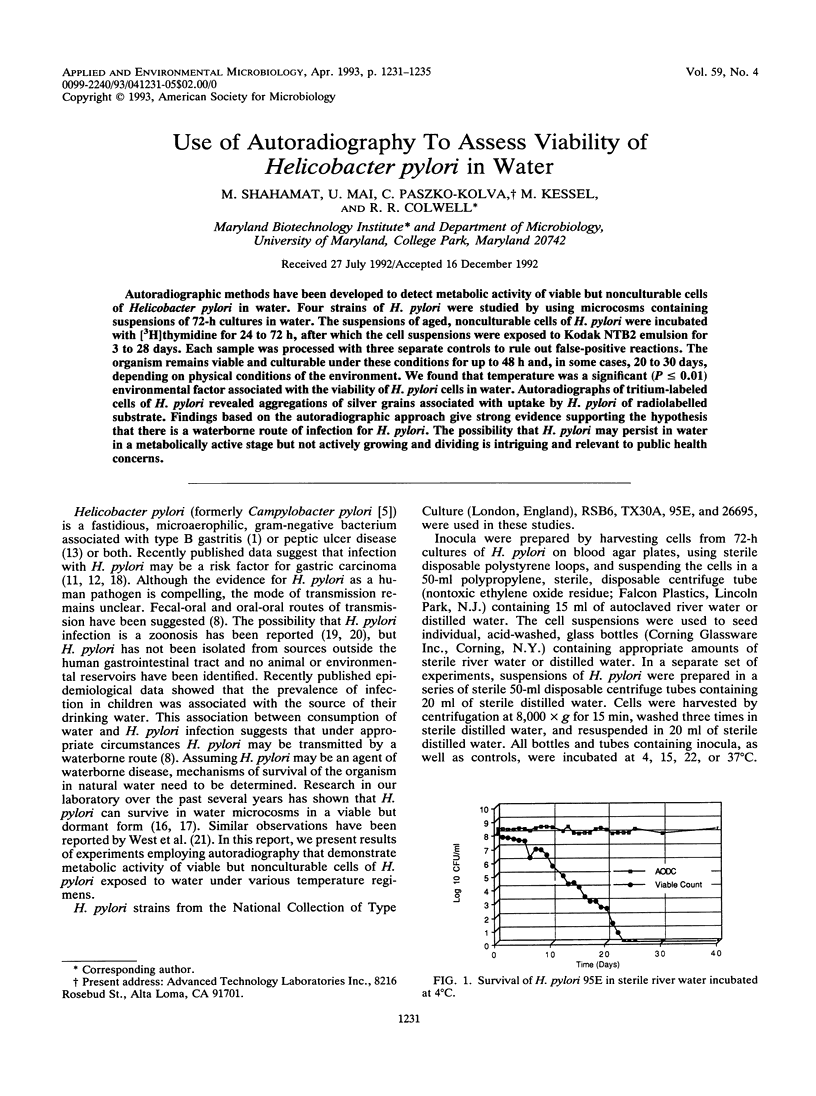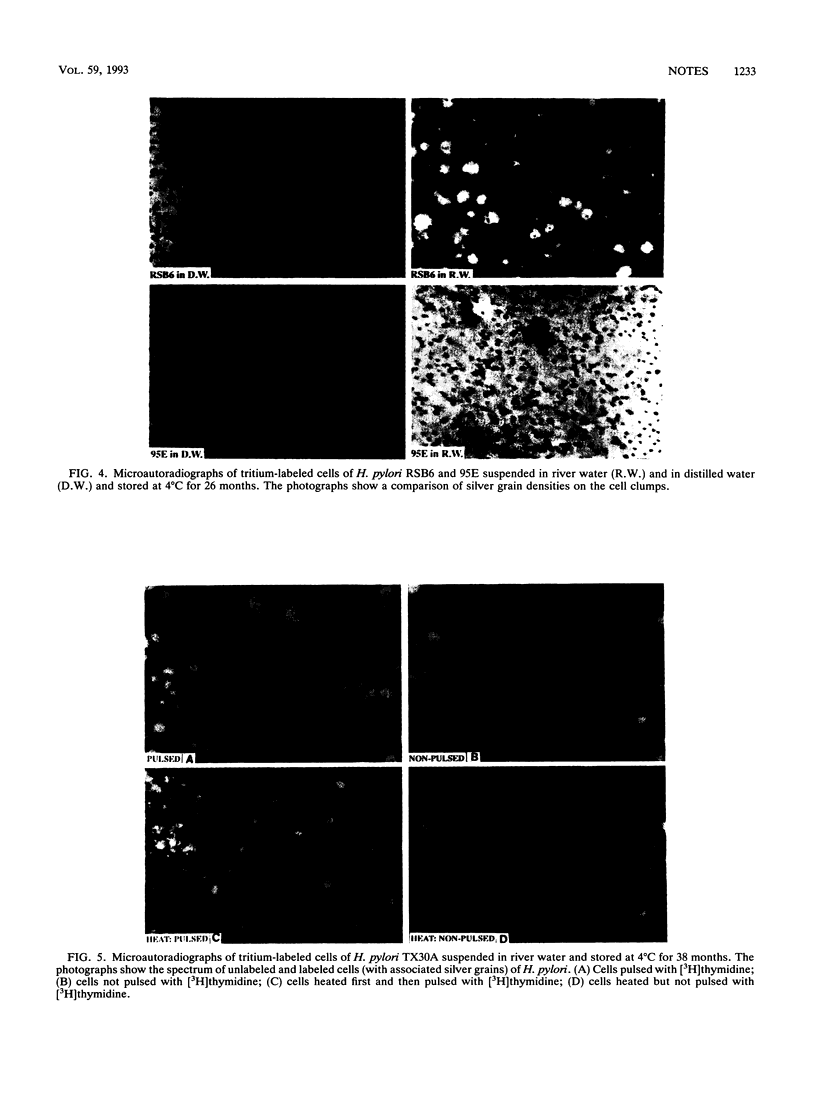Abstract
Autoradiographic methods have been developed to detect metabolic activity of viable but nonculturable cells of Helicobacter pylori in water. Four strains of H. pylori were studied by using microcosms containing suspensions of 72-h cultures in water. The suspensions of aged, nonculturable cells of H. pylori were incubated with [3H]thymidine for 24 to 72 h, after which the cell suspensions were exposed to Kodak NTB2 emulsion for 3 to 28 days. Each sample was processed with three separate controls to rule out false-positive reactions. The organism remains viable and culturable under these conditions for up to 48 h and, in some cases, 20 to 30 days, depending on physical conditions of the environment. We found that temperature was a significant (P < or equal to 0.01) environmental factor associated with the viability of H. pylori cells in water. Autoradiographs of tritium-labeled cells of H. pylori revealed aggregations of silver grains associated with uptake by H. pylori of radiolabelled substrate. Findings based on the autoradiographic approach give strong evidence supporting the hypothesis that there is a waterborne route of infection for H. pylori. The possibility that H. pylori may persist in water in a metabolically active stage but not actively growing and dividing is intriguing and relevant to public health concerns.
Full text
PDF




Images in this article
Selected References
These references are in PubMed. This may not be the complete list of references from this article.
- Buck G. E. Campylobacter pylori and gastroduodenal disease. Clin Microbiol Rev. 1990 Jan;3(1):1–12. doi: 10.1128/cmr.3.1.1. [DOI] [PMC free article] [PubMed] [Google Scholar]
- Fliermans C. B., Schmidt E. L. Autoradiography and immunofluorescence combined for autecological study of single cell activity with Nitrobacter as a model system. Appl Microbiol. 1975 Oct;30(4):676–684. doi: 10.1128/am.30.4.676-684.1975. [DOI] [PMC free article] [PubMed] [Google Scholar]
- Hobbie J. E., Daley R. J., Jasper S. Use of nuclepore filters for counting bacteria by fluorescence microscopy. Appl Environ Microbiol. 1977 May;33(5):1225–1228. doi: 10.1128/aem.33.5.1225-1228.1977. [DOI] [PMC free article] [PubMed] [Google Scholar]
- Klein P. D., Graham D. Y., Gaillour A., Opekun A. R., Smith E. O. Water source as risk factor for Helicobacter pylori infection in Peruvian children. Gastrointestinal Physiology Working Group. Lancet. 1991 Jun 22;337(8756):1503–1506. doi: 10.1016/0140-6736(91)93196-g. [DOI] [PubMed] [Google Scholar]
- Nomura A., Stemmermann G. N., Chyou P. H., Kato I., Perez-Perez G. I., Blaser M. J. Helicobacter pylori infection and gastric carcinoma among Japanese Americans in Hawaii. N Engl J Med. 1991 Oct 17;325(16):1132–1136. doi: 10.1056/NEJM199110173251604. [DOI] [PubMed] [Google Scholar]
- Parsonnet J., Friedman G. D., Vandersteen D. P., Chang Y., Vogelman J. H., Orentreich N., Sibley R. K. Helicobacter pylori infection and the risk of gastric carcinoma. N Engl J Med. 1991 Oct 17;325(16):1127–1131. doi: 10.1056/NEJM199110173251603. [DOI] [PubMed] [Google Scholar]
- Peterson W. L. Helicobacter pylori and peptic ulcer disease. N Engl J Med. 1991 Apr 11;324(15):1043–1048. doi: 10.1056/NEJM199104113241507. [DOI] [PubMed] [Google Scholar]
- Sipponen P., Kosunen T. U., Valle J., Riihelä M., Seppälä K. Helicobacter pylori infection and chronic gastritis in gastric cancer. J Clin Pathol. 1992 Apr;45(4):319–323. doi: 10.1136/jcp.45.4.319. [DOI] [PMC free article] [PubMed] [Google Scholar]
- Taylor D. N., Blaser M. J. The epidemiology of Helicobacter pylori infection. Epidemiol Rev. 1991;13:42–59. doi: 10.1093/oxfordjournals.epirev.a036078. [DOI] [PubMed] [Google Scholar]
- Vaira D., Holton J., Ainley C. C., Lonedi M., Romanos A., Maldini M., Gandolfi L. The source of Campylobacter pylori. Biomed Pharmacother. 1989;43(6):447–450. doi: 10.1016/0753-3322(89)90244-8. [DOI] [PubMed] [Google Scholar]
- West A. P., Millar M. R., Tompkins D. S. Effect of physical environment on survival of Helicobacter pylori. J Clin Pathol. 1992 Mar;45(3):228–231. doi: 10.1136/jcp.45.3.228. [DOI] [PMC free article] [PubMed] [Google Scholar]
- West A. P., Millar M. R., Tompkins D. S. Survival of Helicobacter pylori in water and saline. J Clin Pathol. 1990 Jul;43(7):609–609. doi: 10.1136/jcp.43.7.609-b. [DOI] [PMC free article] [PubMed] [Google Scholar]






